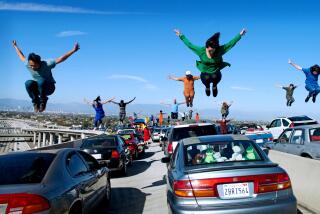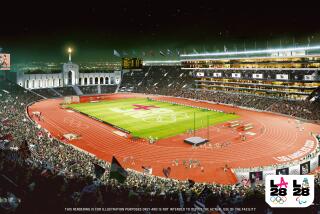Quirky Olympic Course Will Have Players Quaking
- Share via
Let’s face it, the Olympic Club is one eccentric golf course.
The U.S. Open is played on the Lake Course, and there’s not a drop of water on it.
The first hole is a par five and the second and last par five is 15 holes later, No. 16.
There is exactly one fairway bunker on the course, on the left side of No. 6.
The routing is odd, meaning the hole that returns to the clubhouse is No. 8, with No. 9 heading back out.
The San Andreas fault runs under the first fairway out to the Pacific Ocean.
If Augusta National has its so-called Amen Corner, then Olympic has its own name for the stretch of holes from No. 2 through No. 5: Quake Corner. (Don’t blame the Olympic Club, it’s San Andreas’ fault).
There is almost no level ground except for the four par threes.
Say no more. The Olympic has fog, Spanish moss hanging from cypress trees and more than its share of stories that are so odd, they must be true.
A maintenance crew once cut some limbs out of an old cypress tree next to the par-three eighth hole and 105 golf balls fell out. Or so the story goes.
There are supposed to be 40,000 trees at Olympic, which isn’t nearly as amazing as the fact that somebody actually counted them.
The cypress trees have been given a lot of publicity, ever since famed journalist O.B. Keeler, a friend of Bobby Jones, described them as “being designed by a man who had gotten drunk on gin and tried to sober up on absinthe.”
Hall of Fame baseball player Ty Cobb was a member at Olympic in the 1940s when he played a 12-year-old junior member named Bob Rosburg. Cobb lost and was so disgusted, he tossed his sticks in the trunk of his car and never set foot on Olympic again.
The Olympic Club was begun in 1860 and fielded teams for a number of sports in addition to sponsoring some athletes. Gentlemen Jim Corbett, the fighter, was a member and so was basketball star Hank Luisetti from Stanford.
Mark Twain also was a member, although he was neither a fighter nor basketball player, just a writer. They let him in anyway.
Golf became part of the Olympic Club’s sports inventory in 1927 when Sam Whiting redesigned an existing course and it became the Lake Course. The Ocean Course was added.
For this week’s 98th U.S. Open--the fourth at the Olympic Club--the Lake Course will play 6,797 yards with a par 70. The Big Controversy hole (there has to be one) is No. 17, which usually plays to a par five, but the USGA insisted it be a 428-yard par four for the Open.
The Golf Course Superintendents Assn. of America, whose job is to know this sort of thing, said there are 40 acres of rough, 60 acres of fairway and 61 bunkers. The average green size is 4,500 square feet. The wildlife on the course includes rabbit, fox, raccoon, skunk, hawk, raven and quail.
The players hope there also are numerous birdies, but that’s still up in the air. Because the greens are small, some players already have announced that if they find themselves in the rough, they might aim for a greenside bunker and take their chances with an up-and-down from there.
Not so fast, said the USGA, which replaced the coarse, packed sand in the bunkers with white, fluffy stuff to increase the likelihood of plugged lies. Now that’s going to make the players happy.
Meanwhile, the collars around the greens will be narrower than they were for the 1987 Open (20 inches wide down from 30 inches) and the fairways will be squeezed in by an average of two feet.
The 1955 U.S. Open at Olympic was the first to have any appreciable rough. Ben Hogan certainly was aware of that. He hooked his tee shot into the deep rough on the last hole of his playoff with Jack Fleck and made a six.
Since we’re living here in El Ninoland, it’s no small item that the course is regarded as draining well, which may come in handy if there is any more rain at the place. Last month at this time, the Bay Area had reported 110 consecutive days of measurable rainfall. There is a chance that all the flagsticks will be umbrellas.
It should be noted that most of the greens break toward nearby Lake Merced. Wherever that is.
And if you stand on the tee of the downhill, 223-yard par-three third hole, you can see Golden Gate Bridge. If it’s not foggy or raining or umbrellas aren’t in the way.
It also should be noted that if you stand on the 18th tee and look up toward the hilly amphitheater around the green, the bunkers spell I-O-U. Really.
And at the U.S. Open, if the players can’t keep the ball out of the rough and on the green, the Olympic spells out something else: G-O-O-D-B-Y-E.
Now you know.
(BEGIN TEXT OF INFOBOX / INFOGRAPHIC)
Lake Course Background
* The Lake Course at the Olympic Club in San Francisco, site of the 1998 U.S. Open, was originally developed by Willie Watson and Sam Whiting and opened in 1924. Whiting redesigned his original work in 1927.
* Most recently, Robert Trent Jones was brought in to toughen the course in 1953 for the 1955 U.S. Open.
* The U.S. Open has been held at the Olympic Club in 1955 (when Jack Fleck won the championship), 1966 (Billy Casper) and 1987 (Scott Simpson).
* The par 35-35--70 course covers 6,797 yards, 3,340 on the front nine. It is the shortest course the U.S. Open visits.
More to Read
Go beyond the scoreboard
Get the latest on L.A.'s teams in the daily Sports Report newsletter.
You may occasionally receive promotional content from the Los Angeles Times.







